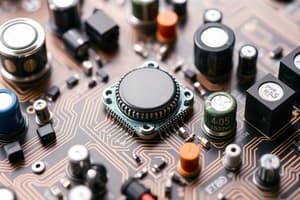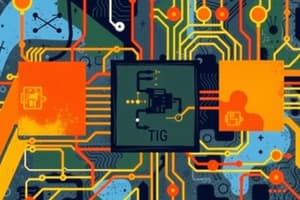Podcast
Questions and Answers
What is the main function of a resistor in an electronic circuit?
What is the main function of a resistor in an electronic circuit?
- Limit current flow and divide voltage (correct)
- Allow current to flow in one direction
- Amplify signals in a circuit
- Store electrical energy
Which law describes the relationship between voltage, current, and resistance?
Which law describes the relationship between voltage, current, and resistance?
- Kirchhoff's Laws
- Newton's Second Law
- Ohm's Law (correct)
- Faraday's Law
In which type of electronics do signals vary continuously?
In which type of electronics do signals vary continuously?
- Analog Electronics (correct)
- Power Electronics
- Control Electronics
- Digital Electronics
What does a diode primarily do in a circuit?
What does a diode primarily do in a circuit?
Which of the following is NOT a typical application of Industrial Electronics?
Which of the following is NOT a typical application of Industrial Electronics?
What is the primary difference between AC and DC current?
What is the primary difference between AC and DC current?
Which of the following best describes the role of a capacitor in electronics?
Which of the following best describes the role of a capacitor in electronics?
What is a key future trend in electronics involving everyday objects connecting to the internet?
What is a key future trend in electronics involving everyday objects connecting to the internet?
Study Notes
Definition
- Electronics refers to the branch of physics and engineering that deals with the emission, behavior, and effects of electrons and their interactions with other particles.
Key Concepts
- Circuit: A closed loop that allows current to flow, composed of components like resistors, capacitors, and inductors.
- Current: The flow of electric charge, measured in amperes (A).
- Voltage: The electric potential difference, measured in volts (V).
- Resistance: The opposition to the flow of current, measured in ohms (Ω).
Components
- Resistors: Limit current flow and divide voltage.
- Capacitors: Store and release electrical energy.
- Inductors: Store energy in a magnetic field when current flows through.
- Diodes: Allow current to flow in one direction only, used for rectification.
- Transistors: Act as switches or amplifiers in circuits.
Types of Electronics
- Analog Electronics: Deals with continuous signals; examples include audio devices and old radios.
- Digital Electronics: Works with discrete signals; examples include computers and digital watches.
Applications
- Consumer Electronics: Smartphones, televisions, and audio equipment.
- Industrial Electronics: Automation systems, sensors, and control systems.
- Communication Systems: Mobile networks, satellite communications, and the internet.
- Medical Equipment: Diagnostic machinery, patient monitoring systems, and imaging devices.
Basic Principles
- Ohm's Law: V = IR (Voltage = Current x Resistance).
- Kirchhoff's Laws: Governs the conservation of charge and energy in electrical circuits (KCL and KVL).
- AC vs. DC: Alternative Current (AC) changes direction periodically; Direct Current (DC) flows in one direction.
Safety Considerations
- Always use insulated tools.
- Be cautious of high voltage.
- Ensure proper grounding of circuits to prevent shock.
Future Trends
- Wearable Electronics: Health monitoring and fitness tracking devices.
- Internet of Things (IoT): Connects everyday objects to the internet for data exchange.
- Flexible Electronics: Develops thin and bendable devices for various applications.
Electronics: The Science of Electrons
- Electronics is the branch of physics and engineering that explores the behavior of electrons and their interactions.
- It encompasses the study of electron emission, movement, and effects.
- Key concepts in electronics include circuits, current, voltage, and resistance.
- A circuit is a closed loop that allows current to flow.
Electronic Components: Building Blocks of Circuits
- Resistors limit the flow of current and divide voltage.
- Capacitors store and release electrical energy, acting as small temporary batteries.
- Inductors store energy in a magnetic field when current flows through them.
- Diodes are one-way gates, allowing current to flow in only one direction. They are crucial for rectification, converting AC to DC.
- Transistors act as switches or amplifiers in circuits, controlled by a small current or voltage.
Analog vs. Digital Electronics: Two Worlds of Signal Processing
- Analog electronics deal with continuous signals, like those found in audio devices and older radios.
- Digital electronics work with discrete signals, represented by ones and zeros. This underlies computers and digital watches.
Applications of Electronics: Shaping Our World
- Consumer electronics encompass smartphones, televisions, and audio equipment, bringing technology into our daily lives.
- Industrial electronics power automation systems, sensors, and control systems across a multitude of industries.
- Communication systems like mobile networks, satellites, and the internet rely heavily on electronic components for signal transmission.
- Medical equipment, including diagnostic machines, patient monitoring systems, and imaging devices, uses electronics to improve healthcare outcomes.
Fundamental Laws of Electronics
- Ohm's Law states that the voltage across a conductor is directly proportional to the current through it, with resistance as the constant of proportionality.
- Kirchhoff's Laws govern the conservation of charge and energy in electrical circuits.
- Kirchhoff's Current Law (KCL) states that the sum of currents entering a node is equal to the sum of currents leaving it.
- Kirchhoff's Voltage Law (KVL) states that in any closed loop, the sum of the voltage drops is equal to the sum of the voltage rises.
AC vs. DC: Two Types of Current Flow
- Alternating current (AC) periodically changes direction, which is commonly used in power grids.
- Direct current (DC) flows in one direction, and is used in devices powered by batteries.
Safety Considerations: Working with Electricity Responsibly
- Always use insulated tools when working with electrical components and circuits.
- Exercise extreme caution when dealing with high voltage.
- Ensure proper grounding of circuits to prevent electric shock.
Emerging Trends in Electronics: The Future is Now
- Wearable electronics, like health monitoring and fitness tracking devices, are becoming increasingly popular and integrated into daily life.
- The Internet of Things (IoT) connects everyday objects to the internet for data exchange, leading to smart homes, cities, and industries.
- Flexible electronics, involving thin and bendable devices, are opening up new possibilities in displays, sensors, and more.
Studying That Suits You
Use AI to generate personalized quizzes and flashcards to suit your learning preferences.
Description
Test your knowledge on the fundamental concepts of electronics, including circuits, current, voltage, and resistance. This quiz covers essential components and types of electronics, providing a comprehensive overview for beginners and enthusiasts alike.




